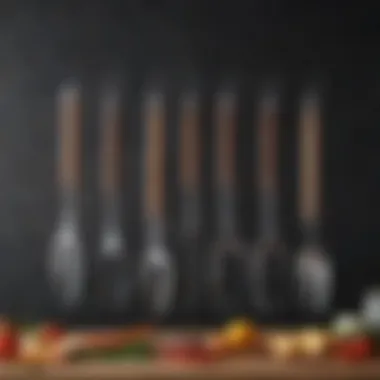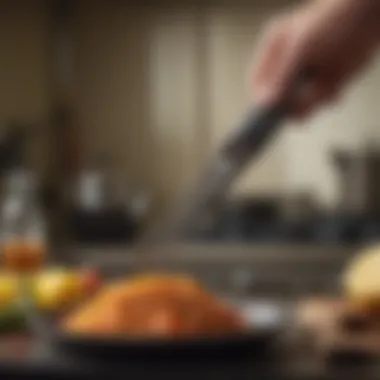Understanding Good Kitchen Tongs: A Comprehensive Guide


Intro
Kitchen tongs often seem like simple tools, yet they play a crucial role in the culinary experience. Knowing how to choose and use tongs effectively can make cooking and food preparation far more efficient. This guide aims to give you insight into what makes tongs essential kitchen tools. By understanding their features, types, and materials, cooks can select and utilize the right tongs for their specific needs.
Tongs are versatile; they can flip meats, toss salads, and serve pasta without the risk of burning fingers. Additionally, assessing their maintenance helps preserve the function and lifespan of these tools. In the next sections, we will dissect what a good set of tongs should entail. This includes features you should look for when purchasing, the different types available, and common materials used in their construction.
The Importance of Kitchen Tongs
Kitchen tongs are an often-overlooked tool in the culinary world, yet their significance in both cooking and food preparation cannot be understated. These utensils play a crucial role in ensuring that food can be handled safely and efficiently. By understanding their importance, one can appreciate the essential nature of these simple tools in enhancing cooking experiences and outcomes.
Functionality in Cooking
One of the primary functions of kitchen tongs is to allow cooks to manipulate food without contact. This is especially relevant when dealing with hot items or foods that require precise handling. For instance, while grilling, tongs enable the flipping and moving of meats and vegetables without breaking them apart. Their design allows chefs to grip foods securely, preventing slips that can lead to burns or spills.
Tongs come in various types, designed for specific culinary tasks. Standard tongs are ideal for general use, while serving tongs cater to buffet-style dishes. Salad tongs have a specific shape that facilitates tossing and mixing greens without crushing them. Grilling tongs, often longer for safety from heat, are designed to lift larger items from a grill. Understanding these distinctions helps one choose the right tongs for the task at hand, enhancing both functionality and efficiency.
Safety Considerations
Considering the potential hazards in kitchens, safety is a paramount concern when using kitchen tongs. They provide a barrier between hot surfaces and hands, thereby preventing burns. However, not all tongs are created equal. Using the right material can significantly influence safety. For instance, metal tongs can withstand high temperatures but may conduct heat; conversely, silicone tongs offer heat resistance while also protecting non-stick surfaces.
It is also vital to ensure that tongs are sturdy enough to hold food securely. A grip that is too weak can lead to food slipping or falling, which can result in accidents or messes. Furthermore, regular maintenance, such as cleaning and inspecting for wear, is important to ensure that tongs remain safe and effective.
"Using the right kitchen tools is paramount for safe and effective cooking. Tongs are no exception."
In summary, kitchen tongs are more than just an accessory; they are essential tools that improve both the functionality and safety of cooking. Whether you are a novice beginner or a seasoned chef, understanding the importance of kitchen tongs can significantly elevate your culinary experience.
Types of Kitchen Tongs
Understanding the types of kitchen tongs is crucial for anyone who spends time in the kitchen. Each type is designed for specific tasks, enhancing functionality and efficiency during cooking and serving. The right tongs can make food handling safer and more precise, helping to improve your overall cooking experience.
Standard Tongs
Standard tongs are the most versatile kitchen tool. They typically feature a long design, allowing for easy handling of hot foods without risking burns. Common materials for standard tongs include stainless steel or silicone tips, which provide good grip and durability. These tongs can effectively flip meats, move pasta, and serve various foods, making them an essential tool for any kitchen.
Considerations for standard tongs include their size and locking mechanism. A well-constructed locking feature allows for compact storage, making these tongs easier to keep when not in use. Look for tongs that have an easy-to-operate locking system for convenience.
Serving Tongs
Serving tongs are specialized for serving food. They usually have a wider grip and a flatter design than standard tongs. With these characteristics, serving tongs help in transferring larger portions of food from cooking pots to dishes. They are often used for serving salad, pasta, or roasted vegetables.
The design of serving tongs can enhance their function. Some come with serrated edges for a better grip on softer foods, while others may have silicone tips to prevent scratching cookware. When choosing serving tongs, consider their length, as you may need longer tongs for deeper serving dishes.
Salad Tongs
Salad tongs are specifically designed for tossing and serving salad. They often come in pairs and may feature a claw-like grip that helps to mix ingredients without bruising them. The materials used for salad tongs can vary, but wooden or plastic options are common to avoid damaging delicate leaves.
It's essential to select salad tongs that are easy to clean and maintain. Their design should also prevent slipping, which can cause spills during serving. This is particularly important when handling dressings or fragile ingredients like herbs.
Grilling Tongs
Grilling tongs are tailored for outdoor cooking and barbecues. They typically have a longer reach than standard tongs, providing safety from flare-ups or high heat. Grilling tongs often feature extra-long handles and can be made from stainless steel, which withstands high temperatures well.
When selecting grilling tongs, pay attention to the tips. Some come with a wide, flat design, which is effective for flipping burgers or handling larger cuts of meat. Others might have a more pointed end to aid in turning kebabs or sausages. Durability is crucial here, as these tongs will be used under very high temperatures.


Materials Used in Kitchen Tongs
The choice of materials used in kitchen tongs plays a significant role. Different materials offer distinct advantages and limitations, influencing their durability, temperature resistance, and ease of use. Selecting the right tongs based on material can affect overall cooking experience and food safety.
Stainless Steel
Stainless steel is a widely favored material for kitchen tongs. Its primary benefit is durability. Tongs made from stainless steel resist rust and corrosion, making them an excellent choice for a range of cooking tasks. The material is also heat resistant, allowing safe use during high-heat cooking, such as grilling or sautéing.
Moreover, stainless steel tongs usually feature a sleek design, enhancing aesthetic appeal in the kitchen. They often include silicone or rubber tips for better grip and to protect cookware surfaces. This combination makes stainless steel tongs versatile, combining strength and functionality.
Silicone
Silicone is another popular option for kitchen tongs. It offers significant advantages when it comes to heat resistance, often able to withstand temperatures up to 500°F. This feature prevents melting or damage during high-heat cooking.
Additionally, silicone tongs are typically gentle on non-stick surfaces, minimizing the risk of scratching. They are flexible, allowing for easy maneuvering of food, making them ideal for serving delicate items, like grilled fish or a salad. The soft grip of silicone also provides comfort during use, reducing strain on hands. However, not all silicone tongs are created equal; one must check for food-grade silicone to ensure safety.
Plastic
Plastic tongs are lightweight and affordable. They are often utilized for casual cooking tasks, such as tossing salads or serving snacks. While plastic tongs are easy to clean and store, they have limitations, especially concerning heat resistance. Most plastic tongs can’t withstand high temperatures, making them unsuitable for direct exposure to flames or very hot pans.
It's crucial to choose high-quality plastic that is BPA-free to avoid health risks. Some plastic tongs may come in vibrant colors, adding a fun element to cooking. However, durability is a concern; they may warp or break over time, necessitating more frequent replacements.
Wooden Tongs
Wooden tongs provide a traditional alternative to metal and plastic options. They are an excellent choice for those who prefer natural materials. Wooden tongs do not conduct heat, reducing burn risk when handling hot foods. They are also non-reactive, making them safe to use with a variety of foods.
One advantage of wooden tongs is their gentle touch on cookware, especially non-stick pans. However, proper care is needed to maintain them. Wooden tongs require regular oiling to prevent drying and cracking. They also need to be washed by hand to extend their lifespan. Lastly, wooden tongs come in an array of styles, adding a rustic aesthetic to your kitchen utensils.
In summary, understanding the materials used in kitchen tongs helps in making an informed choice. Each material has unique benefits and limitations affecting usability, durability, and safety in cooking.
Choosing the Right Tongs
Selecting the right tongs can greatly influence your cooking experience. The right choice enhances functionality and ensures safety while handling food. Whether you're flipping items on the grill or serving a fresh salad, selecting suitable tongs caters to your specific cooking needs. The choice impacts not just performance but also your overall enjoyment in the kitchen.
Size Considerations
Size plays a significant role when choosing kitchen tongs. They come in various lengths, typically ranging from 7 inches to 16 inches. Shorter tongs may provide better control for tasks like dishing out pasta. However, longer tongs are often more effective for grilling or handling hot items without getting too close to the heat.
Choosing the right length also affects your grip and precision. Smaller tongs fit easily in storage and are great for limited space activities. However, if you regularly work with larger pots or grills, investing in longer tongs might be beneficial.
Grip and Comfort
A good grip is essential. Tongs should fit comfortably in your hand, providing excellent control during operation. Look for tongs that feature non-slip handles. Rubber grips or silicone coatings can enhance comfort and reduce fatigue during prolonged use. A comfortable grip allows for precise movements, important when plating food or flipping items on the stovetop.
Consider the ease of operation as well. Tongs with a spring mechanism might allow easier handling than stiff varieties. Your choice should align with your cooking style and frequency of use.
Heat Resistance
Heat resistance is a crucial factor. Kitchen tongs need to withstand high temperatures, especially when used on grills or near stovetops. Tongs made from materials such as stainless steel or heat-resistant silicone tend to perform well under pressure.
Materials that lack proper heat resistance may warp or melt, leading to potential safety hazards. Therefore, evaluating the temperature tolerance of tongs is vital. Always refer to the manufacturer's specifications to ensure durability in high-heat environments.
Storage Options
Finally, consider how you will store your tongs. Some designs feature locking mechanisms, which help secure them in a compact form, saving space in drawers or kitchen utensils holders. Others may come with hanging loops for easy access.


Organizing your kitchen efficiently can prevent accidents and prolonged searches for utensils during cooking sessions. Whether opting for drawer storage or a countertop holder, ensure your tongs remain accessible and safe.
The Role of Tongs in Different Cooking Techniques
Tongs serve essential purposes in various cooking techniques, enhancing both functionality and safety in the kitchen. When handling food, tongs provide control and precision. They replace the need for hands, especially when food is hot or difficult to grasp. Each cooking method benefits from the unique features of tongs, making them versatile tools in culinary practices. In this section, we will examine the role of tongs in sautéing, grilling, and serving, shedding light on their importance in each context.
Sautéing
When it comes to sautéing, tongs are invaluable. This technique requires fast cooking in a small amount of hot fat. With tongs, cooks can easily turn food to ensure even cooking. They allow for a strong grip on delicate items like vegetables, preventing them from breaking apart during the cooking process. Additionally, tongs help keep hands away from the heat, reducing the risk of burns.
In this method, consider the following:
- Control: Tongs provide better control than a spatula for flipping and tossing ingredients.
- Efficiency: The quick motion of tongs helps maintain the food's moisture and flavor.
- Safety: Using tongs minimizes contact with hot surfaces, contributing to a safer cooking environment.
Grilling
Grilling requires well-designed tongs to manage the high temperatures and large pieces of food. Whether flipping burgers or turning skewers, tongs play a crucial role in this method. Sturdy tongs made from heat-resistant materials are preferable.
Here are key aspects of using tongs on the grill:
- Length: Longer tongs keep hands safely away from the flames.
- Grip: A solid grip is essential for handling slippery foods. Tongs with silicone tips prevent slipping.
- Versatility: Tongs can also be used to move hot coals or rearrange items on the grill, enhancing their utility.
Serving
Finally, the significance of tongs in serving cannot be overlooked. Their design allows for effortless transfer of food from serving dishes to plates. Unlike forks, which may pierce the food and affect appearance, tongs provide a gentle way to handle items. This is especially important for serving cooked meats or delicate items like pasta and salads.
Consider the benefits:
- Presentation: Tongs can elevate the presentation of the dish, giving the feeling of care in serving.
- Ease of Use: Serving with tongs requires less effort and can be quicker than using other utensils.
- Hygiene: They eliminate the need for hands in food, promoting a safer serving practice and maintaining cleanliness.
"Using kitchen tongs wisely can significantly improve both the cooking process and serving experience, making it an essential tool in any kitchen."
Maintenance and Care for Kitchen Tongs
Proper maintenance and care of kitchen tongs is crucial for their longevity and performance. Tongs often interact directly with food, which makes keeping them clean and in good condition a necessity. Not only does proper care help maintain hygiene, but it also ensures that the tongs remain functional and safe to use over time. Ignoring maintenance can lead to wear and tear, potentially causing damage to both the tongs and the food being prepared.
Cleaning Methods
Cleaning kitchen tongs is essential to remove any residue from food. Here are some effective methods:
- Hand Washing: This is the most common approach. Use warm soapy water and a sponge. Be sure to pay attention to joints and crevices.
- Dishwasher Safe: Many tongs are safe for the dishwasher. If your tongs fall into this category, place them in the top rack to avoid hot spots that could warp their shape.
- Sanitizing Solutions: Occasionally, it may be prudent to use a sanitizing solution. A mixture of water and vinegar can act as a natural sanitizer. Soak the tongs for a few minutes before rinsing.
Ultimately, a consistent cleaning routine will not only keep tongs looking new, but it will also ensure food safety.
Storage Recommendations
Storing kitchen tongs properly can extend their life and maintain their functionality. Consider these recommendations:
- Magnetic Strips: Utilize a magnetic strip on the wall to keep tongs easily accessible while also preventing them from becoming damaged.
- Drawer Dividers: If storing tongs in a drawer, make use of drawer dividers to prevent them from scratching against other utensils.
- Hanging Hooks: Installing hooks can be a space-saving solution. This keeps tongs visible and within reach, aiding both convenience and care.
"A clean and well-maintained set of kitchen tongs is essential for efficient cooking and food preparation."
Innovative Features in Kitchen Tongs


In today's culinary world, kitchen tongs are not just simple tools. They have evolved to incorporate innovative features that enhance their functionality and versatility. These features are important to consider when selecting the right tongs for specific tasks in the kitchen. Understanding these aspects can lead to more efficient cooking and better safety practices.
Locking Mechanisms
Locking mechanisms are a significant feature in many modern kitchen tongs. This simple yet effective design allows for easy storage and makes the tongs more compact. With a locking mechanism, users can prevent tongs from opening accidentally during storage, which minimizes the risk of injury. Additionally, locking tongs provide more control during use. When the tongs are locked, they can maintain a firm grip on food items, which is especially useful when flipping or lifting heavy items.
Using locking mechanisms can also enhance user comfort. A simple slide or push can secure or release the locking feature, allowing for more flexibility while cooking. This small addition can transform the way you handle food, enabling you to open various food items without losing grip or control. So, when shopping for kitchen tongs, look for those equipped with an effective locking mechanism.
Multi-functional Designs
Today's kitchen tongs often come with multi-functional designs, offering more than just a single purpose. These designs may combine various tools in one, creating a more versatile kitchen accessory. For instance, some tongs feature integrated spatula heads, even basting brushes, or serving utensils. This adaptability limits the number of utensils needed in your kitchen, saving both space and effort while cooking.
Multi-functional tongs can make cooking more efficient. When cooking a diverse meal, tongs that function not only for gripping but also for serving or mixing can streamline the process. This feature is particularly beneficial for those who cook elaborate meals or enjoy entertaining guests. Furthermore, multi-functional tongs can cater to various cooking styles, whether you are grilling, sautéing, or serving.
Investing in tongs with innovative features can greatly enhance your cooking experience, making tasks easier and more enjoyable.
Common Mistakes to Avoid with Kitchen Tongs
Using kitchen tongs can make tasks like flipping, serving, or tossing food easier and more efficient. However, this simple tool comes with its own set of common mistakes. Understanding these missteps can greatly enhance your cooking experience and ensure that your kitchen tongs serve their purpose effectively. Here, we will discuss two frequent errors: using the wrong material and improper storage techniques.
Using the Wrong Material
Selecting tongs made from inappropriate materials can result in various cooking complications. For instance, if you use metal tongs on non-stick surfaces, you risk scratching the coating, which can lead to food sticking to the pan and may affect the pan's longevity. Tongs made of silicone or plastic may be safer for non-stick cookware but could melt or warp if exposed to high heat.
- Stainless Steel Tongs: Excellent for durability and strength but could cause damage to delicate cookware.
- Silicone Tongs: They provide heat resistance and are generally harmless on non-stick surfaces, making them ideal for various cooking methods, yet some may not be sturdy enough for heavy foods.
- Plastic Tongs: These are often light and easy to handle, but poor heat resistance can lead to melting or deformation.
When purchasing tongs, consider what material best matches your cooking style. The right material not only protects your utensils and cookware but also enhances safety and efficiency. Always check the instructions or product specifications to ensure your chosen tongs are suitable for your cooking tasks.
Improper Storage Techniques
Storing kitchen tongs properly is often overlooked but is essential for maintaining their functionality and extending their life span. Misplaced tongs can lose their shape or mechanism.
- Hanging: One practical method is to hang tongs. This can help keep their shape and ensure that they are always easy to access.
- Drawer Storage: Avoid cramming tongs in a crowded drawer. When stored improperly, the joints can become damaged, making them less effective or even unusable.
- Keeping Away from Heat Sources: Ensure that tongs are stored away from heat sources such as ovens or stoves. External heat can warp or damage certain materials.
Improper storage can lead to functionality issues, which may require you to replace them more often. Thus, taking the time to store your tongs correctly can save you both time and money in the long run.
"Proper care and understanding of kitchen tongs contribute immensely to their efficiency and longevity in the kitchen."
Future Trends in Kitchen Tongs
With an increasing focus on sustainability and technology, kitchen tongs are no exception to evolving trends. Understanding these future directions not only informs consumers but also shapes the way we approach cooking and food preparation. The anticipation of innovations in kitchen tongs stems from the need for efficiency, sustainability, and enhanced user experience. Rethinking the materials and functionalities of kitchen tongs may greatly impact our culinary practices.
Eco-Friendly Materials
The movement towards eco-friendly materials is gaining momentum in kitchenware. Consumers are becoming more conscious of their environmental impact. Consequently, manufacturers are exploring sustainable options for producing kitchen tongs. Materials such as bamboo, recycled plastics, and bioplastics are being considered.
The benefits of eco-friendly kitchen tongs extend beyond environmental considerations. They often exhibit durability while being gentler on cookware surfaces. Many eco-friendly tongs are also free from harmful chemicals found in some traditional plastics. This aligns with the growing trend of health-conscious cooking, where safety transcends beyond just food.
When selecting eco-friendly tongs, consider their biodegradability and the effects they may have on your kitchen experience. More brands are now prioritizing transparency about their materials, which aids in making informed choices.
Smart Tongs with Sensors
The integration of technology into kitchen tools signals a new era for tongs. Smart kitchen tongs equipped with sensors are becoming increasingly popular among cooking enthusiasts. These devices can monitor food temperature and provide feedback. For instance, some models can connect to your smartphone, offering cooking alerts to help achieve desired doneness levels.
Smart tongs bring precision to cooking, allowing for better control when frying or grilling. Instead of estimating temperature with traditional methods, users can rely on real-time data. This is incredibly important for meat preparation, as it diminishes the risk of undercooking or overcooking.
Moreover, such advancements can enhance safety in the kitchen. They can reduce the likelihood of burns or accidents by alerting users when they approach high temperatures. As kitchens become smarter, these types of innovations in kitchen tongs could redefine standard cooking practices.
“The future of cooking lies not merely in the ingredients we choose but also in the tools we utilize.”
Embracing these trends may well lead to a transformative shift in both home and professional kitchens. As more cooks seek efficiency and safety, the demand for advanced, sustainable kitchen tongs will likely continue to rise.















